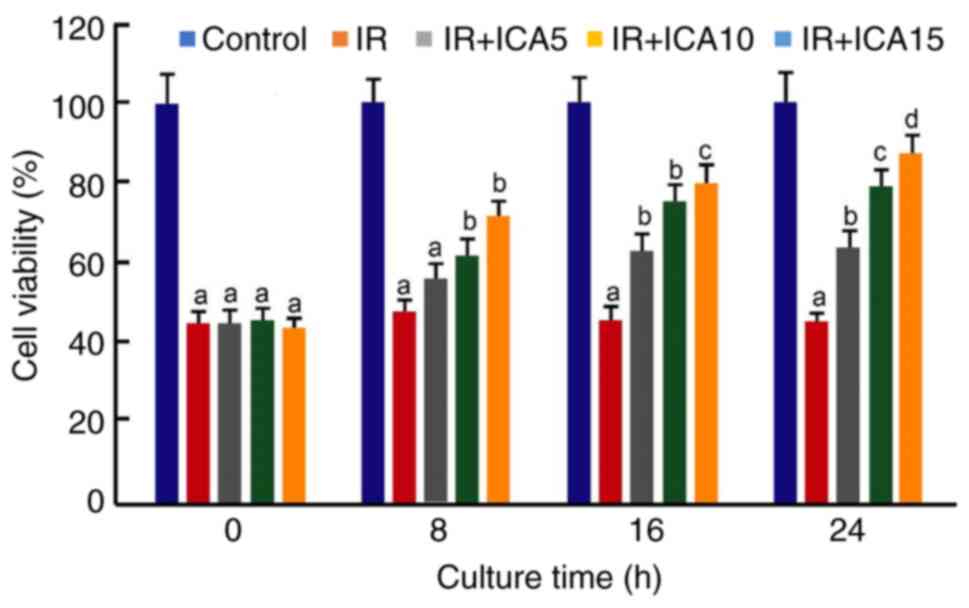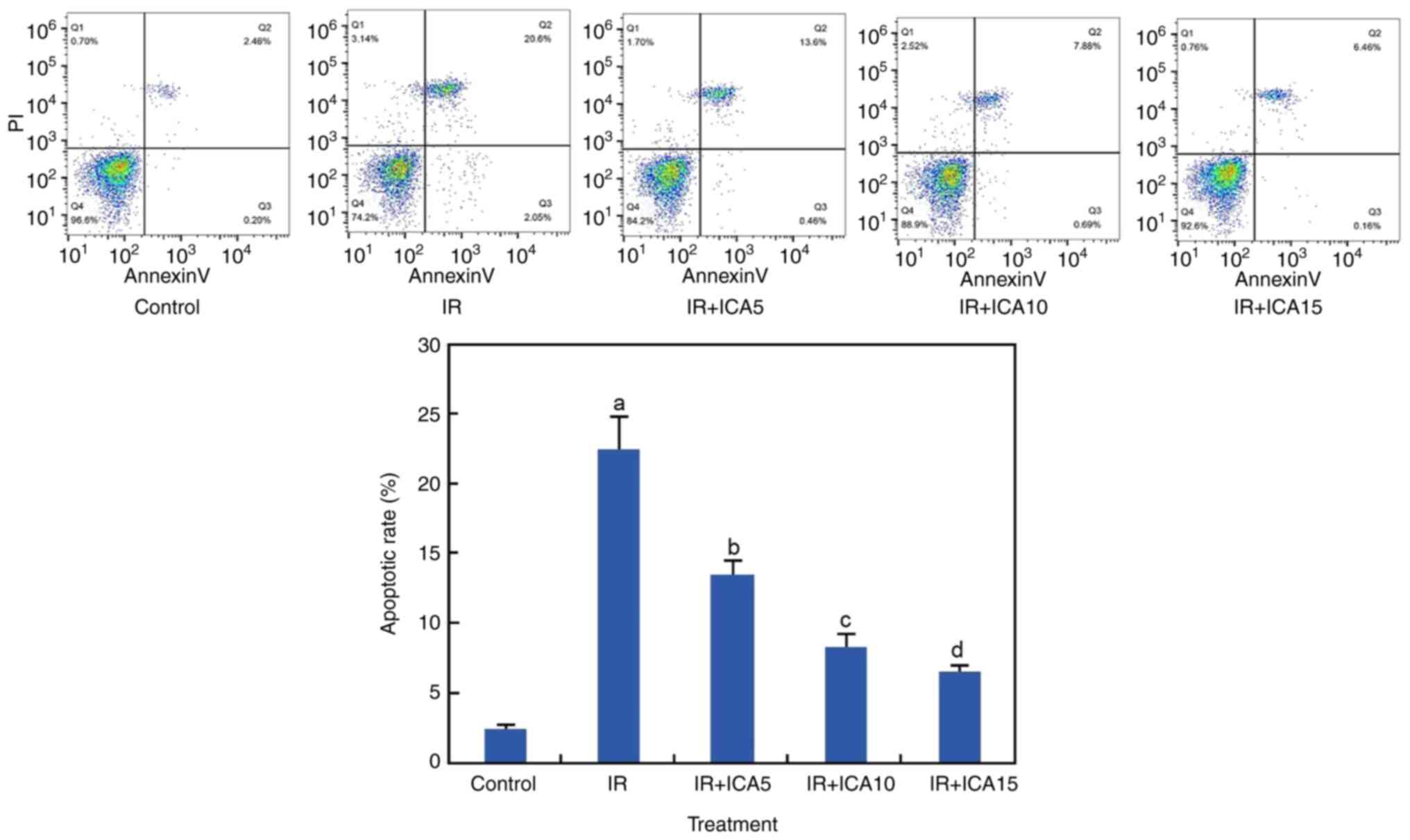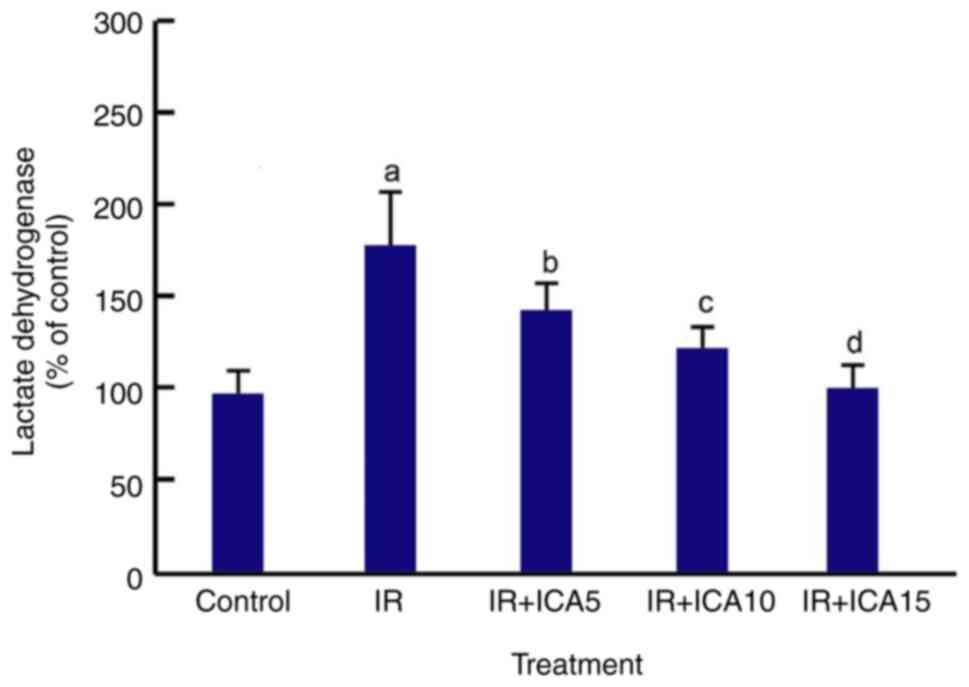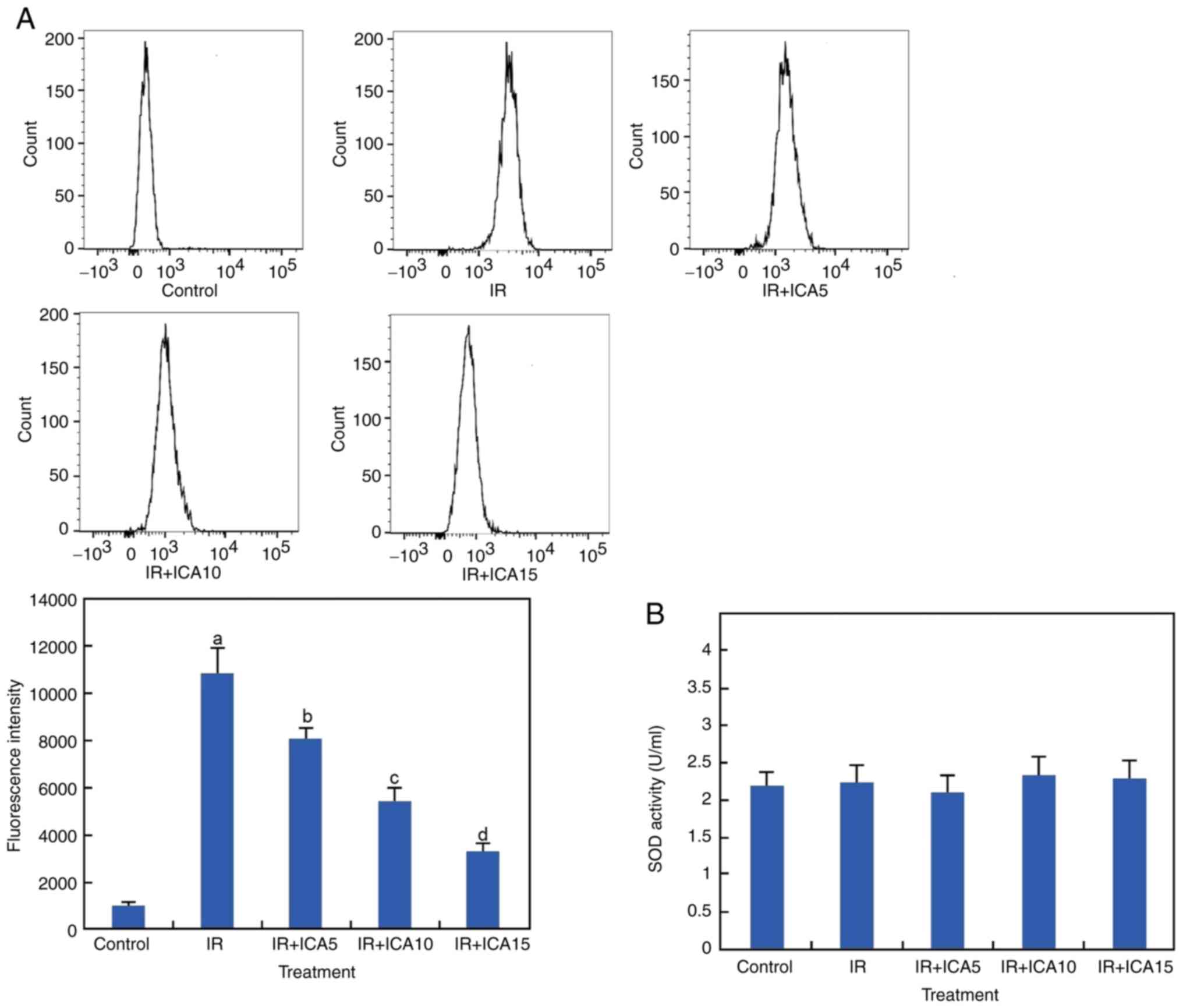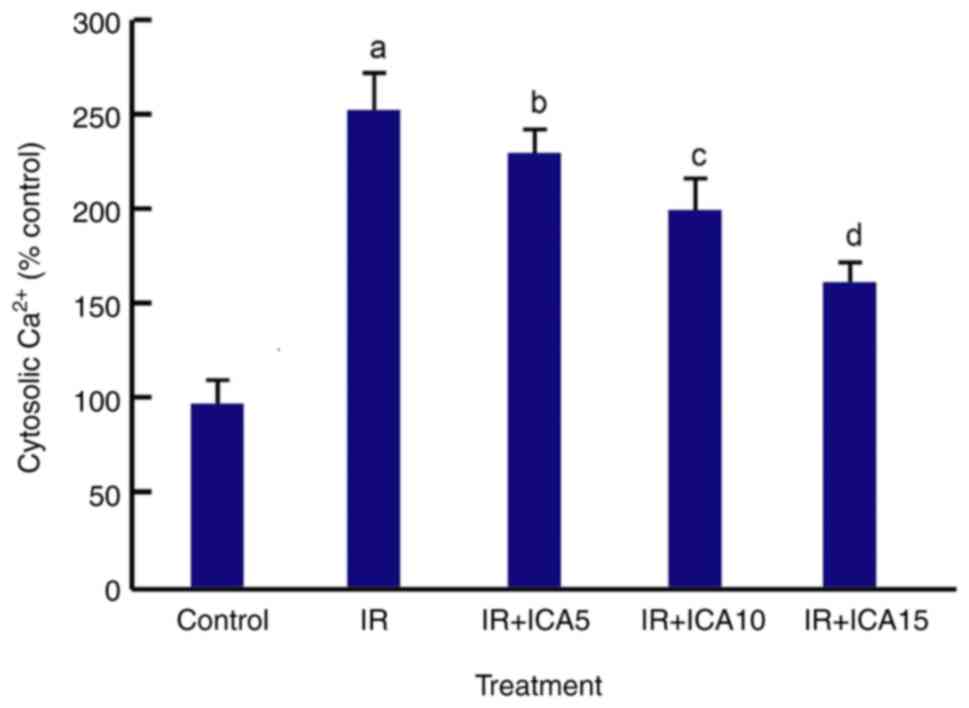|
1
|
Kuriakose D and Xiao Z: Pathophysiology
and treatment of stroke: Present status and future perspectives.
Int J Mol Sci. 21(7609)2020.PubMed/NCBI View Article : Google Scholar
|
|
2
|
Herpich F and Rincon F: Management of
acute ischemic stroke. Crit Care Med. 48:1654–1663. 2020.PubMed/NCBI View Article : Google Scholar
|
|
3
|
Li Y, Li S and Li D: Breviscapine
alleviates cognitive impairments induced by transient cerebral
ischemia/reperfusion through its anti-inflammatory and anti-oxidant
properties in a rat model. ACS Chem Neurosci. 11:4489–4498.
2020.PubMed/NCBI View Article : Google Scholar
|
|
4
|
Kirino T and Sano K: Selective
vulnerability in the gerbil hippocampus following transient
ischemia. Acta Neuropathol. 62:201–208. 1984.PubMed/NCBI View Article : Google Scholar
|
|
5
|
Wu MY, Yiang GT, Liao WT, Tsai AP, Cheng
YL, Cheng PW, Li CY and Li CJ: Current mechanistic concepts in
ischemia and reperfusion injury. Cell Physiol Biochem.
46:1650–1667. 2018.PubMed/NCBI View Article : Google Scholar
|
|
6
|
Sacks BA, Rosenthal DI and Hall FM:
Capsular visualization in lipohemarthrosis of the knee. Radiology.
122:31–32. 1977.PubMed/NCBI View
Article : Google Scholar
|
|
7
|
Yan HF, Tuo QZ, Yin QZ and Lei P: The
pathological role of ferroptosis in ischemia/reperfusion-related
injury. Zool Res. 41:220–230. 2020.PubMed/NCBI View Article : Google Scholar
|
|
8
|
Lee TK, Kang IJ, Kim B, Sim HJ, Kim DW,
Ahn JH, Lee JC, Ryoo S, Shin MC, Cho JH, et al: Experimental
pretreatment with chlorogenic acid prevents transient
ischemia-induced cognitive decline and neuronal damage in the
hippocampus through anti-oxidative and anti-inflammatory effects.
Molecules. 25(3578)2020.PubMed/NCBI View Article : Google Scholar
|
|
9
|
Puyal J, Ginet V and Clarke PG: Multiple
interacting cell death mechanisms in the mediation of
excitotoxicity and ischemic brain damage: A challenge for
neuroprotection. Prog Neurobiol. 105:24–48. 2013.PubMed/NCBI View Article : Google Scholar
|
|
10
|
Drossos G, Lazou A, Panagopoulos P and
Westaby S: Deferoxamine cardioplegia reduces superoxide radical
production in human myocardium. Ann Thorac Surg. 59:169–172.
1995.PubMed/NCBI View Article : Google Scholar
|
|
11
|
Eltzschig HK and Eckle T: Ischemia and
reperfusion-from mechanism to translation. Nat Med. 17:1391–1401.
2011.PubMed/NCBI View
Article : Google Scholar
|
|
12
|
Mahy GE: The effects of clomipramine on
depression in Barbadian patients. West Indian Med J. 27:75–80.
1978.PubMed/NCBI
|
|
13
|
Lee TK, Kim H, Song M, Lee JC, Park JH,
Ahn JH, Yang GE, Kim H, Ohk TG, Shin MC, et al: Time-course pattern
of neuronal loss and gliosis in gerbil hippocampi following mild,
severe, or lethal transient global cerebral ischemia. Neural Regen
Res. 14:1394–1403. 2019.PubMed/NCBI View Article : Google Scholar
|
|
14
|
Victoria ECG, Toscano ECB, Oliveira FMS,
de Carvalho BA, Caliari MV, Teixeira AL, de Miranda AS and Rachid
MA: Up-regulation of brain cytokines and metalloproteinases 1 and 2
contributes to neurological deficit and brain damage in transient
ischemic stroke. Microvasc Res. 129(103973)2020.PubMed/NCBI View Article : Google Scholar
|
|
15
|
Ju F, Ran Y, Zhu L, Gao H, Xi X, Yang Z
and Zhang S: Increased BBB permeability enhances activation of
microglia and exacerbates loss of dendritic spines after transient
global cerebral ischemia. Front Cell Neurosci.
12(236)2018.PubMed/NCBI View Article : Google Scholar
|
|
16
|
Kho AR, Choi BY, Lee SH, Hong DK, Lee SH,
Jeong JH, Park KH, Song HK, Choi HC and Suh SW: Effects of
protocatechuic Acid (PCA) on global cerebral ischemia-induced
hippocampal neuronal death. Int J Mol Sci. 19(1420)2018.PubMed/NCBI View Article : Google Scholar
|
|
17
|
Fecchio C, Palazzi L and de Laureto PP:
α-Synuclein and polyunsaturated fatty acids: Molecular basis of the
interaction and implication in neurodegeneration. Molecules.
23:2018.PubMed/NCBI View Article : Google Scholar
|
|
18
|
Zhang Z, Li G, Szeto SSW, Chong CM, Quan
Q, Huang C, Cui W, Guo B, Wang Y, Han Y, et al: Examining the
neuroprotective effects of protocatechuic acid and chrysin on in
vitro and in vivo models of Parkinson disease. Free Radic Biol Med.
84:331–343. 2015.PubMed/NCBI View Article : Google Scholar
|
|
19
|
Shin MC, Lee TK, Lee JC, Kim HI, Park CW,
Cho JH, Kim DW, Ahn JH, Won MH and Lee CH: Therapeutic effects of
stiripentol against ischemia-reperfusion injury in gerbils focusing
on cognitive deficit, neuronal death, astrocyte damage and blood
brain barrier leakage in the hippocampus. Korean J Physiol
Pharmacol. 26:47–57. 2022.PubMed/NCBI View Article : Google Scholar
|
|
20
|
He C, Wang Z and Shi J: Pharmacological
effects of icariin. Adv Pharmacol. 87:179–203. 2020.PubMed/NCBI View Article : Google Scholar
|
|
21
|
El-Shitany NA and Eid BG: Icariin
modulates carrageenan-induced acute inflammation through HO-1/Nrf2
and NF-kB signaling pathways. Biomed Pharmacother.
120(109567)2019.PubMed/NCBI View Article : Google Scholar
|
|
22
|
Jin J, Wang H, Hua X, Chen D, Huang C and
Chen Z: An outline for the pharmacological effect of icariin in the
nervous system. Eur J Pharmacol. 842:20–32. 2019.PubMed/NCBI View Article : Google Scholar
|
|
23
|
Wang M, Wang L, Zhou Y, Feng X, Ye C and
Wang C: Icariin attenuates renal fibrosis in chronic kidney disease
by inhibiting interleukin-1β/transforming growth factor-β-mediated
activation of renal fibroblasts. Phytother Res. 35:6204–6215.
2021.PubMed/NCBI View Article : Google Scholar
|
|
24
|
Zheng Y, Lu L, Yan Z, Jiang S, Yang S,
Zhang Y, Xu K, He C, Tao X and Zhang Q: mPEG-icariin nanoparticles
for treating myocardial ischaemia. Artif Cells Nanomed Biotechnol.
47:801–811. 2019.PubMed/NCBI View Article : Google Scholar
|
|
25
|
Li L, Tsai HJ, Li L and Wang XM: Icariin
inhibits the increased inward calcium currents induced by
amyloid-beta (25-35) peptide in CA1 pyramidal neurons of neonatal
rat hippocampal slice. Am J Chin Med. 38:113–125. 2010.PubMed/NCBI View Article : Google Scholar
|
|
26
|
Mo ZT, Liao YL, Zheng J and Li WN: Icariin
protects neurons from endoplasmic reticulum stress-induced
apoptosis after OGD/R injury via suppressing IRE1α-XBP1 signaling
pathway. Life Sci. 255(117847)2020.PubMed/NCBI View Article : Google Scholar
|
|
27
|
Ahlemeyer B and Baumgart-Vogt E: Optimized
protocols for the simultaneous preparation of primary neuronal
cultures of the neocortex, hippocampus and cerebellum from
individual newborn (P0.5) C57Bl/6J mice. J Neurosci Methods.
149:110–120. 2005.PubMed/NCBI View Article : Google Scholar
|
|
28
|
Goldberg MP and Choi DW: Combined oxygen
and glucose deprivation in cortical cell culture: Calcium-dependent
and calcium-independent mechanisms of neuronal injury. J Neurosci.
13:3510–3524. 1993.PubMed/NCBI View Article : Google Scholar
|
|
29
|
Flammang TJ, Yerokun T, Bryant MS, Couch
LH, Kirlin WG, Lee KJ, Ogolla F, Ferguson RJ, Talaska G and Hein
DW: Hemoglobin adduct and hepatic- and urinary bladder-DNA adduct
levels in rapid and slow acetylator Syrian inbred hamsters
administered 2-aminofluorene. J Pharmacol Exp Ther. 260:865–871.
1992.PubMed/NCBI
|
|
30
|
Ma D, Zhao L, Zhang L, Li Y, Zhang L and
Li L: Icariin promotes survival, proliferation, and differentiation
of neural stem cells in vitro and in a rat model of Alzheimer's
disease. Stem Cells Int. 2021(9974625)2021.PubMed/NCBI View Article : Google Scholar
|
|
31
|
Kumar P, Nagarajan A and Uchil PD:
Analysis of cell viability by the lactate dehydrogenase assay. Cold
Spring Harb Protoc:. 2018, 2018 doi: 10.1101/pdb.prot095497.
|
|
32
|
Gelband CH and Gelband H: Ca2+ release
from intracellular stores is an initial step in hypoxic pulmonary
vasoconstriction of rat pulmonary artery resistance vessels.
Circulation. 96:3647–3654. 1997.PubMed/NCBI View Article : Google Scholar
|
|
33
|
Wang Z, Wang D, Yang D, Zhen W, Zhang J
and Peng S: The effect of icariin on bone metabolism and its
potential clinical application. Osteoporos Int. 29:535–544.
2018.PubMed/NCBI View Article : Google Scholar
|
|
34
|
Song L, Chen X, Mi L, Liu C, Zhu S, Yang
T, Luo X, Zhang Q, Lu H and Liang X: Icariin-induced inhibition of
SIRT6/NF-kappaB triggers redox mediated apoptosis and enhances
anti-tumor immunity in triple-negative breast cancer. Cancer Sci.
111:4242–4256. 2020.PubMed/NCBI View Article : Google Scholar
|
|
35
|
Zhang YW, Morita I, Zhang L, Shao G, Yao
XS and Murota S: Screening of anti-hypoxia/reoxygenation agents by
an in vitro method. Part 2: Inhibition of tyrosine kinase
activation prevented hypoxia/reoxygenation-induced injury in
endothelial gap junctional intercellular communication. Planta Med.
66:119–123. 2000.PubMed/NCBI View Article : Google Scholar
|
|
36
|
Ali S, Ansari S, Ehtesham NZ, Azfer MA,
Homkar U, Gopal R and Hasnain SE: Analysis of the evolutionarily
conserved repeat motifs in the genome of the highly endangered
central Indian swamp deer Cervus duvauceli branderi. Gene.
223:361–367. 1998.PubMed/NCBI View Article : Google Scholar
|
|
37
|
Khezri MR and Ghasemnejad-Berenji M:
Icariin: A potential neuroprotective agent in Alzheimer's Disease
and Parkinson's disease. Neurochem Res. 47:2954–2962.
2022.PubMed/NCBI View Article : Google Scholar
|
|
38
|
Alluri H, Anasooya Shaji C, Davis ML and
Tharakan B: Oxygen-glucose deprivation and reoxygenation as an in
vitro ischemia-reperfusion injury model for studying blood-brain
barrier dysfunction. J Vis Exp. (e52699)2015.PubMed/NCBI View
Article : Google Scholar
|
|
39
|
Liu L, Zhao Z, Yin Q and Zhang X: TTB
protects astrocytes against oxygen-glucose
deprivation/reoxygenation-induced injury via activation of
Nrf2/HO-1 signaling pathway. Front Pharmacol.
10(792)2019.PubMed/NCBI View Article : Google Scholar
|
|
40
|
Zhi SM, Fang GX, Xie XM, Liu LH, Yan J,
Liu DB and Yu HY: Melatonin reduces OGD/R-induced neuron injury by
regulating redox/inflammation/apoptosis signaling. Eur Rev Med
Pharmacol Sci. 24:1524–1536. 2020.PubMed/NCBI View Article : Google Scholar
|
|
41
|
Sun B, Ou H, Ren F, Huan Y, Zhong T, Gao M
and Cai H: Propofol inhibited autophagy through
Ca2+/CaMKKβ/AMPK/mTOR pathway in OGD/R-induced neuron injury. Mol
Med. 24(58)2018.PubMed/NCBI View Article : Google Scholar
|
|
42
|
Zhou JM, Gu SS, Mei WH, Zhou J, Wang ZZ
and Xiao W: Ginkgolides and bilobalide protect BV2 microglia cells
against OGD/reoxygenation injury by inhibiting TLR2/4 signaling
pathways. Cell Stress Chaperones. 21:1037–1053. 2016.PubMed/NCBI View Article : Google Scholar
|
|
43
|
Stankovic Stojanovic K and Lionnet F:
Lactate dehydrogenase in sickle cell disease. Clin Chim Acta.
458:99–102. 2016.PubMed/NCBI View Article : Google Scholar
|
|
44
|
Shaw P and Chattopadhyay A: Nrf2-ARE
signaling in cellular protection: Mechanism of action and the
regulatory mechanisms. J Cell Physiol. 235:3119–3130.
2020.PubMed/NCBI View Article : Google Scholar
|
|
45
|
Ma Q: Role of nrf2 in oxidative stress and
toxicity. Annu Rev Pharmacol Toxicol. 53:401–426. 2013.PubMed/NCBI View Article : Google Scholar
|
|
46
|
Kumar M, Singh G, Kushwah AS, Surampalli
G, Singh TG and Gupta S: Arbutin protects brain against middle
cerebral artery occlusion-reperfusion (MCAo/R) injury. Biochem
Biophys Res Commun. 577:52–57. 2021.PubMed/NCBI View Article : Google Scholar
|
|
47
|
Lindblom RPF, Tovedal T, Norlin B,
Hillered L, Englund E and Thelin S: Mechanical Reperfusion
following prolonged global cerebral ischemia attenuates brain
injury. J Cardiovasc Transl Res. 14:338–347. 2021.PubMed/NCBI View Article : Google Scholar
|
|
48
|
Dirnagl U, Iadecola C and Moskowitz MA:
Pathobiology of ischaemic stroke: An integrated view. Trends
Neurosci. 22:391–397. 1999.PubMed/NCBI View Article : Google Scholar
|
|
49
|
Hossmann KA: Pathophysiology and therapy
of experimental stroke. Cell Mol Neurobiol. 26:1057–1083.
2006.PubMed/NCBI View Article : Google Scholar
|
|
50
|
McColl BW, Rothwell NJ and Allan SM:
Systemic inflammation alters the kinetics of cerebrovascular tight
junction disruption after experimental stroke in mice. J Neurosci.
28:9451–9462. 2008.PubMed/NCBI View Article : Google Scholar
|
|
51
|
Bazinet RP and Laye S: Polyunsaturated
fatty acids and their metabolites in brain function and disease.
Nat Rev Neurosci. 15:771–785. 2014.PubMed/NCBI View Article : Google Scholar
|
|
52
|
Li X, Cheng S, Hu H, Zhang X, Xu J, Wang R
and Zhang P: Progranulin protects against cerebral
ischemia-reperfusion (I/R) injury by inhibiting necroptosis and
oxidative stress. Biochem Biophys Res Commun. 521:569–576.
2020.PubMed/NCBI View Article : Google Scholar
|
|
53
|
Wang Q, Tompkins KD, Simonyi A, Korthuis
RJ, Sun AY and Sun GY: Apocynin protects against global cerebral
ischemia-reperfusion-induced oxidative stress and injury in the
gerbil hippocampus. Brain Res. 1090:182–189. 2006.PubMed/NCBI View Article : Google Scholar
|
|
54
|
Lievre V, Becuwe P, Bianchi A, Koziel V,
Franck P, Schroeder H, Nabet P, Dauça M and Daval JL: Free radical
production and changes in superoxide dismutases associated with
hypoxia/reoxygenation-induced apoptosis of embryonic rat forebrain
neurons in culture. Free Radic Biol Med. 29:1291–1301.
2000.PubMed/NCBI View Article : Google Scholar
|
|
55
|
Liu J, Hou J, Xia ZY, Zeng W, Wang X, Li
R, Ke C, Xu J, Lei S and Xia Z: Recombinant PTD-Cu/Zn SOD
attenuates hypoxia-reoxygenation injury in cardiomyocytes. Free
Radic Res. 47:386–393. 2013.PubMed/NCBI View Article : Google Scholar
|
|
56
|
Sun HY, Wang NP, Kerendi F, Halkos M, Kin
H, Guyton RA, Vinten-Johansen J and Zhao ZQ: Hypoxic
postconditioning reduces cardiomyocyte loss by inhibiting ROS
generation and intracellular Ca2+ overload. Am J Physiol Heart Circ
Physiol. 288:H1900–H1908. 2005.PubMed/NCBI View Article : Google Scholar
|
|
57
|
Yoon JW, Lee SE, Park YG, Kim WJ, Park HJ,
Park CO, Kim SH, Oh SH, Lee DG, Pyeon DB, et al: The antioxidant
icariin protects porcine oocytes from age-related damage in vitro.
Anim Biosci. 34:546–557. 2021.PubMed/NCBI View Article : Google Scholar
|
|
58
|
Hu Y and Ma X: Icariin treatment protects
against gentamicin-induced ototoxicity via activation of the
AMPK-SIRT3 pathway. Front Pharmacol. 12(620741)2021.PubMed/NCBI View Article : Google Scholar
|
|
59
|
Juan CA, Perez de la Lastra JM, Plou FJ
and Perez-Lebena E: The chemistry of reactive oxygen species (ROS)
revisited: Outlining their role in biological macromolecules (DNA,
Lipids and Proteins) and induced pathologies. Int J Mol Sci.
22(4642)2021.PubMed/NCBI View Article : Google Scholar
|
|
60
|
Wang X, Lu X, Zhu R, Zhang K, Li S, Chen Z
and Li L: Betulinic acid induces apoptosis in differentiated PC12
Cells Via ROS-Mediated mitochondrial pathway. Neurochem Res.
42:1130–1140. 2017.PubMed/NCBI View Article : Google Scholar
|
|
61
|
Kaminskyy VO and Zhivotovsky B: Free
radicals in cross talk between autophagy and apoptosis. Antioxid
Redox Signal. 21:86–102. 2014.PubMed/NCBI View Article : Google Scholar
|
|
62
|
Angeloni C, Barbalace MC and Hrelia S:
Icariin and Its metabolites as potential protective phytochemicals
against Alzheimer's Disease. Front Pharmacol.
10(271)2019.PubMed/NCBI View Article : Google Scholar
|
|
63
|
Mensah A, Chen Y, Asinyo BK, Howard EK,
Narh C, Huang J and Wei Q: Bioactive Icariin/β-CD-IC/Bacterial
cellulose with enhanced biomedical potential. Nanomaterials
(Basel). 11(387)2021.PubMed/NCBI View Article : Google Scholar
|
|
64
|
Lu R, Zhang T, Wu D, He Z, Jiang L, Zhou M
and Cheng Y: Production of functional human CuZn-SOD and EC-SOD in
bitransgenic cloned goat milk. Transgenic Res. 27:343–354.
2018.PubMed/NCBI View Article : Google Scholar
|
|
65
|
Fridovich I: Superoxide radical and
superoxide dismutases. Annu Rev Biochem. 64:97–112. 1995.PubMed/NCBI View Article : Google Scholar
|
|
66
|
Li L, Zhou QX and Shi JS: Protective
effects of icariin on neurons injured by cerebral
ischemia/reperfusion. Chin Med J (Engl). 118:1637–1643.
2005.PubMed/NCBI
|
|
67
|
Grzybowska EA: Calcium-Binding proteins
with disordered structure and their role in secretion, storage, and
cellular signaling. Biomolecules. 8(42)2018.PubMed/NCBI View Article : Google Scholar
|
|
68
|
Verkhratsky A and Toescu EC: Endoplasmic
reticulum Ca(2+) homeostasis and neuronal death. J Cell Mol Med.
7:351–361. 2003.PubMed/NCBI View Article : Google Scholar
|
|
69
|
Roderick HL and Cook SJ: Ca2+ signalling
checkpoints in cancer: Remodelling Ca2+ for cancer cell
proliferation and survival. Nat Rev Cancer. 8:361–375.
2008.PubMed/NCBI View Article : Google Scholar
|
|
70
|
Wu AJ, Tong BC, Huang AS, Li M and Cheung
KH: Mitochondrial calcium signaling as a therapeutic target for
Alzheimer's Disease. Curr Alzheimer Res. 17:329–343.
2020.PubMed/NCBI View Article : Google Scholar
|
|
71
|
Santulli G, Nakashima R, Yuan Q and Marks
AR: Intracellular calcium release channels: An update. J Physiol.
595:3041–3051. 2017.PubMed/NCBI View Article : Google Scholar
|
|
72
|
Lawal TA, Todd JJ, Witherspoon JW,
Bönnemann CG, Dowling JJ, Hamilton SL, Meilleur KG and Dirksen RT:
Ryanodine receptor 1-related disorders: An historical perspective
and proposal for a unified nomenclature. Skelet Muscle.
10(32)2020.PubMed/NCBI View Article : Google Scholar
|
|
73
|
Harukuni I and Bhardwaj A: Mechanisms of
brain injury after global cerebral ischemia. Neurol Clin. 24:1–21.
2006.PubMed/NCBI View Article : Google Scholar
|
|
74
|
Sun JB, Wang Z and An WJ: Protection of
icariin against hydrogen peroxide-induced MC3T3-E1 cell oxidative
damage. Orthop Surg. 13:632–640. 2021.PubMed/NCBI View Article : Google Scholar
|
|
75
|
Zima AV and Blatter LA:
Inositol-1,4,5-trisphosphate-dependent Ca(2+) signalling in cat
atrial excitation-contraction coupling and arrhythmias. J Physiol.
555:607–615. 2004.PubMed/NCBI View Article : Google Scholar
|
|
76
|
Jiang W, Zeng M, Cao Z, Liu Z, Hao J,
Zhang P, Tian Y, Zhang P and Ma J: Icariin, a novel blocker of
sodium and calcium channels, eliminates early and delayed
afterdepolarizations, as well as triggered activity, in rabbit
cardiomyocytes. Front Physiol. 8(342)2017.PubMed/NCBI View Article : Google Scholar
|















